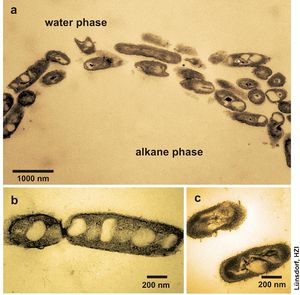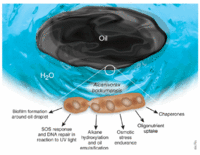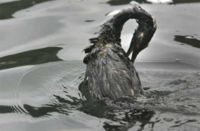Microvirgula aerodenitrificans: Difference between revisions
| Line 22: | Line 22: | ||
Microvirgula aerodenitrificans | Microvirgula aerodenitrificans | ||
== | ==Introduction== | ||
M. aerodenitrificans are abile to performs denitrification under aerobic condition [1,3,5]. While most denitrifiers utilize nitrate and nitrite as terminal electron acceptors under anaerobic conditions, , M. aerodenitrificans reduces both oxygen and nitrogen simultaneously when oxygen is present [5]. However, the biological significance is not defined yet for aerobic denitrification. The habitat for this organism is not specified and found in a various places globally where selective pressure such as fluctuating oxygen concentration occurs[7,8]. These places are mostly sludge, mixture of wastewater treatment and also found in canal and a pond [8]. | |||
Until 2012, Microvirgula aerodenitrificans has not been described as a causative organism of clinical infection. However, the first human case has been recently reported in where M. aerodenitrificans was linked to bacteremia in a 15-month-old infant boy with Pompe’s disease. The disease causality of the organism itself is not yet proven but it is shown that such organism can influence vascular access mechanism and may lead to a clinical disease especially for a person with an immunodeficiency [2]. | |||
==Genome Structure== | ==Genome Structure== | ||
Revision as of 02:08, 14 December 2012

Classification
Domain: Bacteria
Phylum: Proteobacteria
Class: Betaproteobacteria
Order: Neisseriales
Family: Neisseriaceae
Genus: Microvirgula
Species: aerodenitrificans
Species
Microvirgula aerodenitrificans
Introduction
M. aerodenitrificans are abile to performs denitrification under aerobic condition [1,3,5]. While most denitrifiers utilize nitrate and nitrite as terminal electron acceptors under anaerobic conditions, , M. aerodenitrificans reduces both oxygen and nitrogen simultaneously when oxygen is present [5]. However, the biological significance is not defined yet for aerobic denitrification. The habitat for this organism is not specified and found in a various places globally where selective pressure such as fluctuating oxygen concentration occurs[7,8]. These places are mostly sludge, mixture of wastewater treatment and also found in canal and a pond [8]. Until 2012, Microvirgula aerodenitrificans has not been described as a causative organism of clinical infection. However, the first human case has been recently reported in where M. aerodenitrificans was linked to bacteremia in a 15-month-old infant boy with Pompe’s disease. The disease causality of the organism itself is not yet proven but it is shown that such organism can influence vascular access mechanism and may lead to a clinical disease especially for a person with an immunodeficiency [2].
Genome Structure

The Alcanivorax borkumensis strain SK2, isolated from a seawater sediment sample in the North Sea at a site located near the Isle of Borkum, was the first hydrocarbonoclastic bacterium to be sequenced and was completed by Susanne Schneiker et al. It's genome consists of a single circular chromosome with 3,120,143 base pairs and an average G+C content of 54.7%. The genomic analysis of A. borkumensis SK2 revealed several new insights into the bacterium's role for (i) n-alkane degradation (which includes metabolism, biosurfactant production and biofilm production), (ii) it's system for capturing or scavenging the small amounts of nitrogen, phosphorous, sulfur, and other elements in a nutrient-poor marine environment which allows for more efficient alkane degradation due to their main limitation of nutrient availability, (iii) as well as means for coping with stress factors such as high salt contents and high UV radiation since it thrives mostly in the upper layers in the ocean where UV light is encountered (Figure 3).
It's genome encodes several systems for the catabolism of hydrocarbons which allow the bacertium to degrade all sorts of alkanes such as AlkB1 alkane hydroxylase which oxidizes medium-chain alkanes in the range of C5-C12, and AlkB2 alkane hydroxylase which oxidizes medium-chain alkanes in the range of C8 to C16. Both these systems are located close to the origin of replication of the chromosome. A. borkumensis is also able to degrade alkanes up to C32, branched aliphatic hydrocarbons, isoprenoid hydrocarbons such as phytane, as well as alkylarenes and alkylcycloalkanes. Thus, the genome encodes for a broad spectrum of systems for the catabolism of hydrocarbons, giving it a competitive advantage over other oil-degrading marine microbial communities. To deal with the damaging effects of UV light, A. borkumensis has a number of genes that reduce the damage. These include the full genes for DNA alkylation, recombinational and nucleotide excision repair, base excision repair, as well as the SOS response [4].
Cell Structure, Metabolism and Life Cycle
Alcanivorax borkumensis, a Gram-negative, rod-shaped chemoorganotroph, is able to use n-alkanes as its principle carbon and energy source by use of the broad spectrum of oil-degrading enzymes it possesses, but they can also use a limited number of organic compounds such as aliphatic hydrocarbons, volatile fatty acids, and pyruvate. However, it cannot utilize carbon sources such as sugars or amino acids. Cells grown with pyruvate were observed to be 2.0-3.0 micrometers in length and 0.4-07 micrometers in diameter, however, cells were shorter (1.0-1.5 micrometers in length) when cells were grown with n-alkanes as the carbon source (see Figure 1) [5]. When the slow growing A. borkumensis uses n-alkanes exclusively, the microbes produce extracellular and membrane-bound surface-active glucose lipids called biosurfactants. These biosurfactants reduce the surface tension of water from 72 to 29 mN m-1 and act as natural emulsifiers which enhances the break up of oil-in-water emulsions [4,5]. Due to the low solubility of oil in water, most oil degradation takes place at the oil-water interface where A. borkumensis attaches and forms a biofilm around the oil droplets as depicted in Figure 3.
Ecology
Alcanivorix is a novel species living in the oceans that plays a major role in keeping our pristine oceans as well as the inhabitants of the ocean and the inhabitants of the coastal regions in good health. It has been detected worldwide in places such as the Mediterranean Sea, Pacific Ocean, and the Arctic Sea [4]. In seawater with high concentrations of n-alkanes (as a result of oil spills, natural oil fields, and/or processing plants), Alcanivorax quickly becomes the predominant microbial community and is found in higher populations when compared to Alcanivorax in unpolluted seawater. There have been several recent fields studies on bacterial community dynamics and hydrocarbon degradation in coastal areas contaminated with oil. These field studies have demonstrated the immense importance of Alcanivorax (particularly A. Borkumensis) in oil-spill bioremediation [2].
References
[3] Lorenzo, Víctor De. "Blueprint of an Oil-eating Bacterium." Nature Biotechnology 24 (2006): 952-953.
Author
Page authored by Andrew Buss, student of Prof. Jay Lennon at Michigan State University.

